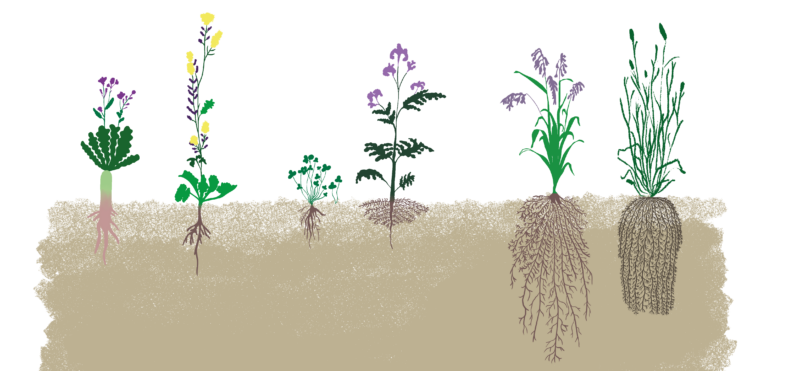In just a handful of healthy soil, there are more microorganisms than there are humans on Earth. 90% of this life resides in the top 15 centimeters of soil.
With regenerative agriculture, we adapt to the soil rather than altering it. This means minimizing soil disturbance and external inputs. Instead, we strategically plant cover crops between vine rows to naturally enrich the soil, tailored to the specific needs of the vines. The selection of plant species varies according to soil type and its nutrient needs, which differ from plot to plot and year to year. There is no one-size-fits-all solution.

Illusration : Laurie – Bilden Studio
Here are some examples that we use in our plots (from left to right in the illustration above) :
Daikon & Mustard : Daikon radish and mustard, both from the cruciferous family, have the ability to break up compacted soil and extract nutrients that are hard for the vine to access (such as phosphorus). They reduce nematodes, harmful small worms, and prevent weeds from growing, reducing the need for human intervention.
Clover & Phacelia: Clover and phacelia, both from the legume family, are complementary because they do not grow at the same time. They fix nitrogen, which is essential for plant tissue development. Phacelia also attracts many beneficial insects to the vineyard.
Rye & Oats: Rye and oats, both from the grass family, are also complementary and have strong soil structuring abilities due to their extensive root networks. They play a crucial role in the formation of humus, a soil life reservoir that nourishes plants.
These three plant families produce organic matter, a source of energy for future crops, store carbon, and thereby increase soil fertility. They regulate the soil microclimate, preserve moisture, and prevent erosion.
When do we sow? We sow after the grape harvest to to leverage the autumn rains. We sow all seeds simultaneously for operational efficiency and to minimize soil disruption. Any seeds that do not germinate immediately remain in the soil, providing long-term benefits.
As we transition towards a no-till practice, we continuously enrich the diversity of our cover crops with complementary plant species. This approach is aimed at meeting the evolving needs of the soil, with the goal of achieving self-sufficiency in several years. This marks a significant step in the regeneration journey of our soil, following years of tilling.
To enter our website, you must be of legal drinking age in your country.